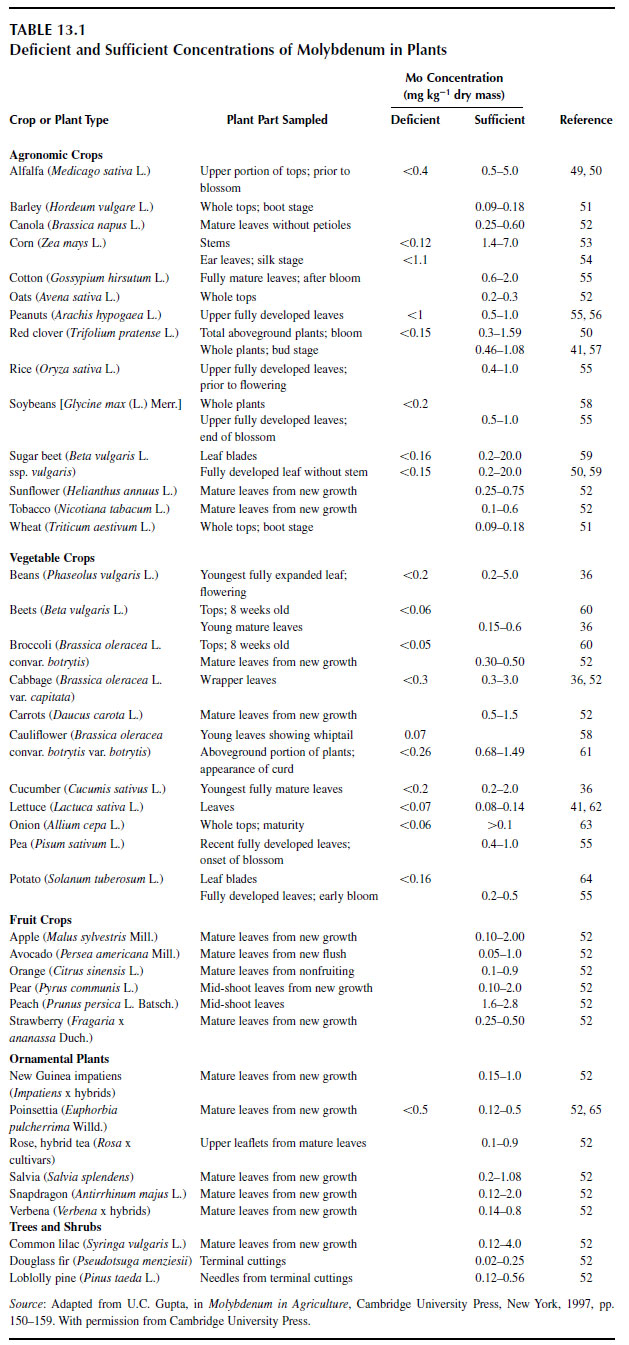Molybdenum Concentration and Distribution in Plants
The requirement of plants for molybdenum is lower than any other mineral nutrient except nickel (Ni) (9). Plants differ in their ability to absorb molybdenum from the root medium (48), and the sufficiency range for molybdenum in plants varies widely (Table 13.1). Most plants contain sufficient levels of molybdenum-in the range of 0.2 to 2.0 mg Mo kg-1-in their dry tissue, but the difference between the critical deficiency and toxicity levels can vary up to a factor of 104 (e.g., 0.1 to 1000 mg Mo kg-1 dry mass) (9).The source of nitrogen supplied to plants influences their requirement for molybdenum. Nitratefed plants generally have a high requirement for molybdenum (66), but there are conflicting reports as to whether plants supplied with reduced nitrogen have a molybdenum requirement. Cauliflower developed symptoms of molybdenum deficiency when grown with ammonium salts, urea, glutamate, or nitrate, in the absence of molybdenum (20). However, Hewitt (67) suggested that the molybdenum requirement, in the presence of reduced nitrogen, may result from the effects of traces of nitrate derived from bacterial nitrification. When cauliflower plants were supplied ammonium sulfate and no molybdenum under sterile conditions, Hewitt and Gundry (68) found that plants showed no abnormalities and apparently had no molybdenum requirement. On transfer to nonsterile conditions, whiptail symptoms appeared as a characteristic symptom of molybdenum deficiency. Hewitt (17) later stated that molybdenum is of very little importance for some plants if nitrate reduction is not necessary for nitrogen assimilation, but that it is impossible to say that an element is not required by plants given the limits of current analytical techniques.
 |
Molybdenum is absorbed by plant roots in the form of the molybdate ion (MoO42-), and its uptake is considered to be controlled metabolically (19). In long-distance transport in plants, molybdenum is readily mobile in the xylem and phloem (32). The form in which molybdenum is translocated is unknown, but its chemical properties indicate that it is most likely transported as MoO42- rather than in a complexed form (9). The proportion of various molybdenum constituents in plants naturally depends on the quantity of molybdenum absorbed and accumulated in the tissue. Molybdenum-containing enzymes, such as nitrogenase and nitrate reductase, constitute a major pool for absorbed molybdenum, but under conditions of luxury consumption, excess molybdenum can also be stored in the vacuoles of peripheral cell layers of the plant (69).
The allocation of molybdenum to the various plant organs varies considerably among plant species, but generally the concentration of molybdenum is highest in seeds (12) and in the nodules of N2-fixing plants (9). However, when molybdenum is limiting, preferential accumulation in root nodules may lead to considerably lower molybdenum content in the shoots and seeds of nodulated legumes (70). Molybdenum concentrations in leaves have been found to exceed concentrations in the stems of several crop species such as tomato, alfalfa (Medicago sativa L.), and soybeans (Glycine max Merr.) (12).




